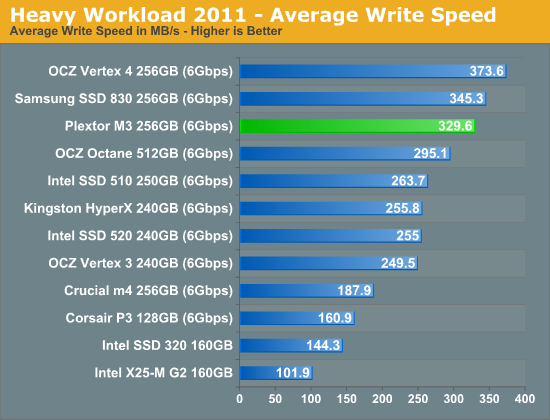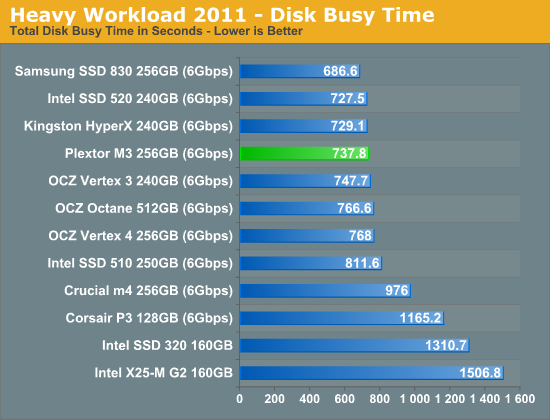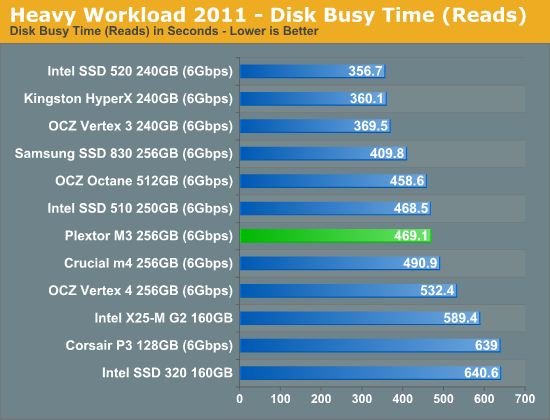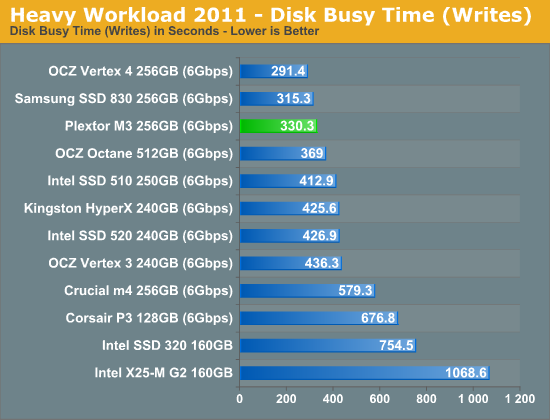The Plextor M3 (256GB) Review
by Kristian Vättö on April 5, 2012 3:05 AM ESTAnandTech Storage Bench 2011
Last year we introduced our AnandTech Storage Bench, a suite of benchmarks that took traces of real OS/application usage and played them back in a repeatable manner. Anand assembled the traces out of frustration with the majority of what we have today in terms of SSD benchmarks.
Although the AnandTech Storage Bench tests did a good job of characterizing SSD performance, they weren't stressful enough. All of the tests performed less than 10GB of reads/writes and typically involved only 4GB of writes specifically. That's not even enough exceed the spare area on most SSDs. Most canned SSD benchmarks don't even come close to writing a single gigabyte of data, but that doesn't mean that simply writing 4GB is acceptable.
Originally we kept the benchmarks short enough that they wouldn't be a burden to run (~30 minutes) but long enough that they were representative of what a power user might do with their system. Later, however, we created what we refer to as the Mother of All SSD Benchmarks (MOASB). Rather than only writing 4GB of data to the drive, this benchmark writes 106.32GB. This represents the load you'd put on a drive after nearly two weeks of constant usage. And it takes a long time to run.
1) The MOASB, officially called AnandTech Storage Bench 2011—Heavy Workload, mainly focuses on the times when your I/O activity is the highest. There is a lot of downloading and application installing that happens during the course of this test. Our thinking was that it's during application installs, file copies, downloading, and multitasking with all of this that you can really notice performance differences between drives.
2) We tried to cover as many bases as possible with the software incorporated into this test. There's a lot of photo editing in Photoshop, HTML editing in Dreamweaver, web browsing, game playing/level loading (Starcraft II and WoW are both a part of the test), as well as general use stuff (application installing, virus scanning). We included a large amount of email downloading, document creation, and editing as well. To top it all off we even use Visual Studio 2008 to build Chromium during the test.
The test has 2,168,893 read operations and 1,783,447 write operations. The IO breakdown is as follows:
| AnandTech Storage Bench 2011—Heavy Workload IO Breakdown | ||||
| IO Size | % of Total | |||
| 4KB | 28% | |||
| 16KB | 10% | |||
| 32KB | 10% | |||
| 64KB | 4% | |||
Only 42% of all operations are sequential; the rest ranges from pseudo to fully random (with most falling in the pseudo-random category). Average queue depth is 4.625 IOs, with 59% of operations taking place in an IO queue of 1.
Many of you have asked for a better way to really characterize performance. Simply looking at IOPS doesn't really say much. As a result we're going to be presenting Storage Bench 2011 data in a slightly different way. We'll have performance represented as Average MB/s, with higher numbers being better. At the same time we'll be reporting how long the SSD was busy while running this test. These disk busy graphs will show you exactly how much time was shaved off by using a faster drive vs. a slower one during the course of this test. Finally, we will also break out performance into reads, writes, and combined. The reason we do this is to help balance out the fact that this test is unusually write intensive, which can often hide the benefits of a drive with good read performance.
There's also a new light workload for 2011. This is a far more reasonable, typical every day use case benchmark. It has lots of web browsing, photo editing (but with a greater focus on photo consumption), video playback, as well as some application installs and gaming. This test isn't nearly as write intensive as the MOASB but it's still multiple times more write intensive than what we were running last year.
We don't believe that these two benchmarks alone are enough to characterize the performance of a drive, but hopefully along with the rest of our tests they will help provide a better idea. The testbed for Storage Bench 2011 has changed as well. We're now using a Sandy Bridge platform with full 6Gbps support for these tests.
AnandTech Storage Bench 2011—Heavy Workload
We'll start out by looking at average data rate throughout our new heavy workload test:

Samsung SSD 830 continues to dominate our Heavy suite but in both read and write, but the M3 is the fastest Marvell based SSD and delivers a result 32% faster than the Crucial m4. Overall the M3 is on-par with SandForce—it does worse in read speed but takes that back in write speed.


The next three charts just represent the same data, but in a different manner. Instead of looking at average data rate, we're looking at how long the disk was busy for during this entire test. Note that disk busy time excludes any and all idles; this is just how long the SSD was busy doing something:













113 Comments
View All Comments
Kutark - Thursday, April 5, 2012 - link
I thought it kind of odd that the author hadn't heard of plextor until a couple of months ago. IMO basically anybody who had been building their own comps since the mid 90's should at least have heard of the brand.I wonder how old the author is. This kind of reminds me of when you mention Everquest in a conversation and the WOW generation has no clue what you're talking about.
BTW im not meaning to imply or say anything negative about the author, it just struck me as an odd thing to say.
Kutark - Thursday, April 5, 2012 - link
Well, had i read the comments i would seen that the author is 18, which explains quite a lot (again, not in a bad way)jabber - Thursday, April 5, 2012 - link
I thought the Plextor of old went bust years ago and the name was bought up by someone else?Basically standard goods with the Plextor name silkscreened on for 50% extra mark up.
I just threw out my trusty Plextor 712SA drive after about 8 years hard use.
Topweasel - Thursday, April 5, 2012 - link
No, as DVD burners became throwaway items (Sub $50) they started to offer re-branded parts, but higher quality ones. You could still tell from little things like the tray mechanism that they weren't Plextor. They also ran into a stumbling block with optics for DVD burners for the few they still manufactured. Since they are compared to the big ones, more of a boutique designer they had trouble at 16x+ of eeking out that last bit of quality. Which meant for their more expensive drives, they weren't king of the hill, meaning if reliability and not burning performance or burn quality were your concerns, then you wouldn't pay the extra amount. For the rebrands, they were actually price competitive even if they were like $5-$10 bucks more.Then came Blu-Ray drives. That did almost kill them. No one was/is buying them. Not like they would DVD drives. Internal drives also never hit the extremes that for example a DVD drive did at launch where they were $300-$400. So once again they were manufacturing expensive drives that no one was buying, and they couldn't even rebrand to make it more price competitive. That's why they went to SSD's, unlike OCZ that made the move because SSD's where much higher margin parts. Plextor did it to survive. But again they don't even have to make to many of these. Plextor makes its living as a low volume high quality high performance manufacturer. Even at their worse in 2008-2010, they were only just as good as everyone else. SSD's are just a product that they can produce that performance actually matters and higher prices are acceptable.
But no Plextor today is the same Plextor of old. Just with a new focus, but same goal.
Beenthere - Thursday, April 5, 2012 - link
Plextor has the potential to sell some decent SSDs. I think the M3 Pro should be the base model with the 3M pricing and Plextor should work on a true Pro model. The Pro pricing is unacceptable and the M3 performance lacking IMO.GrizzledYoungMan - Thursday, April 5, 2012 - link
Any reason to use 10.2 over 10.6?Kristian Vättö - Thursday, April 5, 2012 - link
From a user's standpoint, no. For reviews it's important to use the same set of software and drivers as an updated version may impact performance. In other words, we would have to test all SSDs again if we updated Intel RST to 10.6. That's why we are sticking with 10.2, at least for now.Maiyr - Thursday, April 5, 2012 - link
"Plextor as a brand is probably a new acquaintance for most people and I have to admit that I had not heard of Plextor until a couple of months ago."I must be getting old. That just seems crazy to me.
Maiyr
jwilliams4200 - Thursday, April 5, 2012 - link
With regards to idle power, the 256GB Crucial m4 shows half the idle power of the 256GB Vertex 4 in your chart, but they both have the same amount of synchronous flash.And since they are both using a Marvell controller (the V4 has a rebadged Marvell 88SS9187, the m4 has an 88SS9174), it is clear that the biggest factor in idle power consumption is NOT the amount and type of flash memory.
Kristian Vättö - Friday, April 6, 2012 - link
You really need some proof that the Indilinx Everest 2 is just a rebadged Marvell 88SS9187, I've seen nothing that indicates so.Of course the controller draws power as well and it can lead to high power consumption, so NAND is definitely not the only factor - I was only pointing out that Toggle NAND is more power efficient. It's possible that a future firmware update will decrease the power consumption of Vertex 4, that happened with Vertex 3 at least.